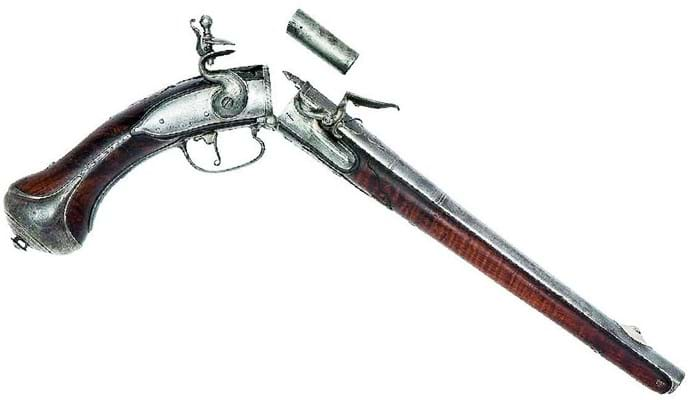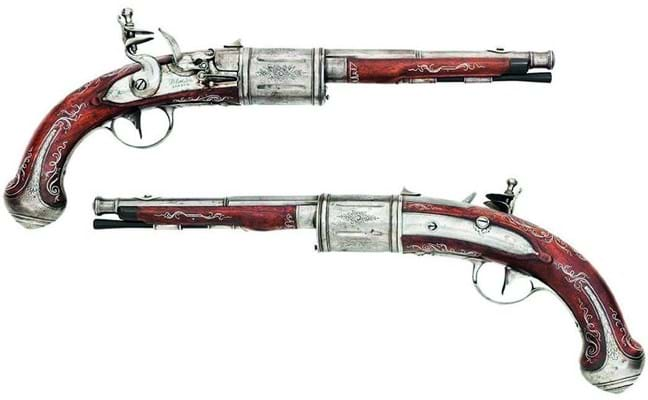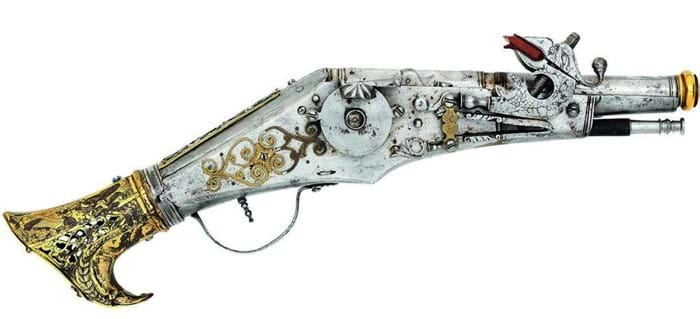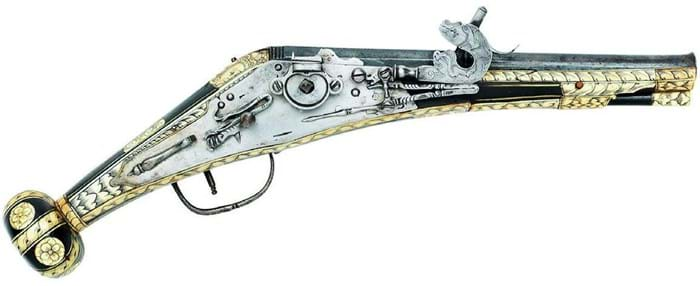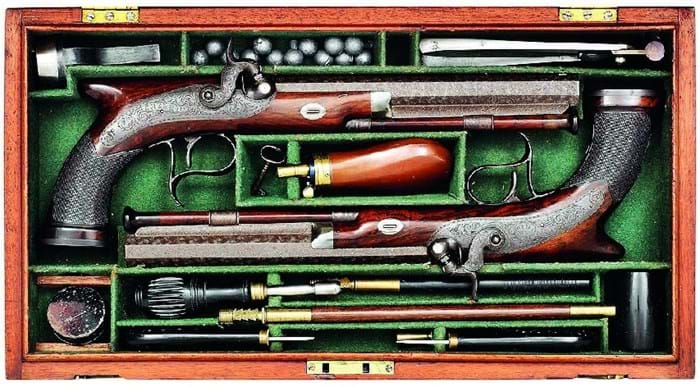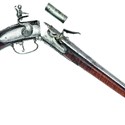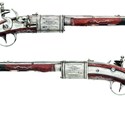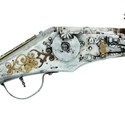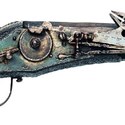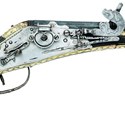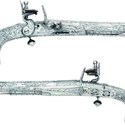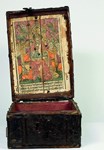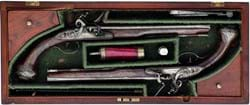Chief contributors to this great buying opportunity were two private collections offered in separate catalogues by Bonhams (25/12.5% buyer’s premium) in Knightsbridge on November 28.
The morning featured the sale of the collection of the late Daniel Williams, whose passion for firearms was kindled in childhood.
He initially concentrated on 19th century American pistols and rifles, but later on English and Irish flintlocks and percussion guns. Arms from both categories contributed handsomely to this session led by a cased pair of saw-handled percussion duelling or target pistols by Wm & Jn Rigby of Dublin at £10,000.
In the afternoon it was the turn of Richard J Garrett, a well-known figure in gun-collecting circles whose interest in all types of firearm included the early middle-European wheel-locks which tend to eclipse even the finest English cased pistols of the Georgian period. It was these and a couple of technical rarities from later periods which prompted the most competitive bidding.
The wheel-lock was the first really efficient mechanical means of ignition for firearms and Richard Garret had accumulated several prime examples from the late 16th or early 17th century.
A 17th century Augsburg holster pistol in 32-bore, with a cock formed as two sea monsters and a stock overlaid with foliate engraved staghorn, sold for £16,000. The same sum also acquired a brass-barrelled German wheel-lock hand-mortar of c.1600, stocked in fruitwood with overall inlaid brass scrolls.
An unusual all-metal German belt pistol of the late 16th century at £13,000, a Saxon ball-pommelled ‘Puffer’ pistol dated 1592 at £14,000 and a pair of elegant long holster pistols by Hans Stockman of Dresden, c.1610, at £15,000, were further evidence of the great strength of the collection in early wheel-locks.
Technical rarities
Perhaps even more remarkable were the two great technical rarities in the collection, both innovative attempts to increase the fire-power of the flintlock.
Pre-dating the widespread adoption of breech-loading cartridge guns by more than a century and a half was a 22-bore break-action flintlock holster pistol made c.1690 by Andrew Dolep of London. Not only did this have a hinged tip-down barrel allowing easy loading of pre-charged steel cartridges, it was also fitted with a detachable pan fed from a spring-operated priming magazine.
Such far-sighted developments were rare in the 17th century, even for gunsmiths as ingenious as Dolep, who arrived in London from Holland and established himself as a leading maker.
Equally precocious, though dating from a century later, was a pair of Russian 55-bore flintlock revolvers, signed Polinson, London. These were fitted with numbered cylinders which could be pre-loaded and rotated by hand, so that the firer had only to cock and prime before taking another shot.
Both these lots could be said to be of museum quality. The pair to the Dolep pistol is in the V&A, while another pair of six-shot flintlocks by Ivan Polin are in the Hermitage.
Each lot sold for £22,000.
Multi-shot breakthrough
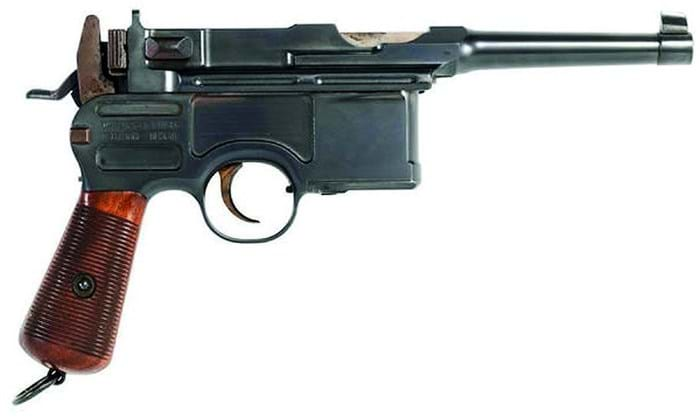
A .763 Mauser C96 magazine pistol with a rare combined cocking lever and safety catch – £10,000 at Bonhams.
The dream of an efficient automatic multi-shot pistol finally began to be realised in the final decade of the 19th century, but the styling of these deadly heralds of the machine age showed none of the Art Nouveau exuberance of the Belle Epoque.
Two good examples of this utilitarian design trend turned up in the London sales.
The .763mm Mauser C96 semi-auto pistol was introduced in 1896 and was generally known as The Broomhandle due to its decidedly inelegant grip.
However, its power and efficiency were quickly recognised and it was adopted unofficially by many British officers.
They included Winston Churchill who famously gave it a ringing endorsement in his account of his part in the 1898 Battle of Omdurman, where he used it to shoot a number of Dervishes at point-blank range.
With around a million of these pistols manufactured over 40 years, they are far from uncommon, but the example offered at Bonhams’ multi-owner sale on November 29 was a rare variant of the 1902 model, fitted with a combined cocking lever and safety catch, making it much safer to carry while loaded.
It is thought that only a few dozen of this variant were produced and this one reached £10,000.
Colt and Browning
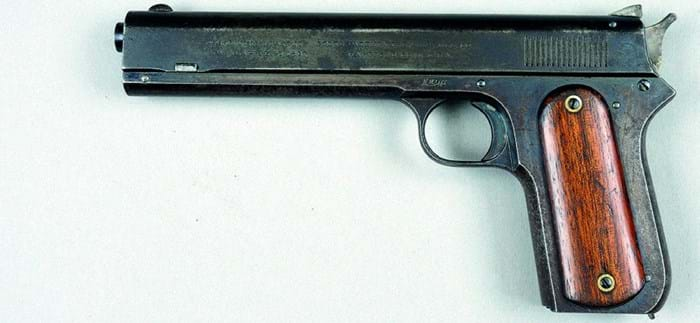
A Colt M1900 .38 automatic with a combined rear sight and safety catch – £3000 at Gavin Gardiner’s sale.
Meanwhile, on the other side of the Atlantic, Colt was developing its own semi-automatic pistol based on the designs of John Browning.
An example of the slab-sided .38 M1900 turned up at Gavin Gardiner’s (25% buyer’s premium) December 12 sale in London where it made £3000.
Browning stripped this version of all extra catches and levers. Once again the safety catch was a defining feature. In this case it was a simple adaptation of the rear sight which could be depressed to block the fall of the hammer.
This proved cumbersome in practice and was soon abandoned.


